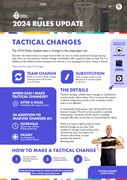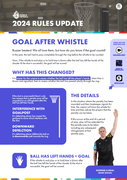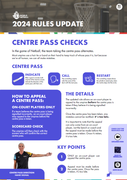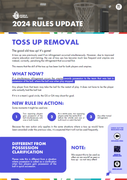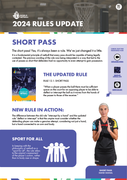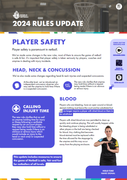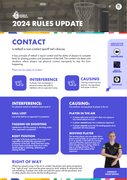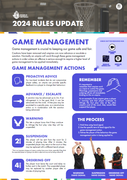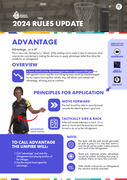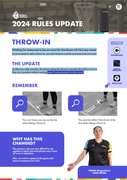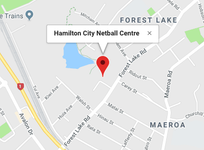The below are summaries of the new rules.
For details watch the World Netball Rules and download the .pdfs on this page. Also click on the links below.
To view the new rules book, click here.
You can also download the Rules of Netball App for free via Apple or Google Stores.
The new rule means teams no longer have to fake an injury to make positional changes during
play, they can just request a ‘tactical change’ immediately after a goal has been scored. This is in
addition to the ability to make changes at an interval or at a stoppage for injury, illness or blood.
There are two types of changes:
1) Team Change - When an on-court player changes playing positions with another on-court player.
2) Substitution - When a player moves from the team bench to replace a player on the court.
Buzzer beaters! We all love them, but how do you know if the goal counts?
In the past, the ball had to pass completely through the ring before the whistle to be counted.
Now, if the whistle to end play or to hold time is blown after the ball has left the hands of the shooter & the shot is successful, the goal will be scored.
The updated rule allows an on-court player to appeal to the umpires before the centre pass is taken if they believe it is being signalled incorrectly.
Once the centre pass has been taken, any mistakes cannot be rectified- it’s too late.
1) Indicate
2) Call
3) Restart
The good old toss up! It’s gone!
A toss up was previously used if an infringement occurred simultaneously. However, due to improved umpire education and training, the use of toss ups has become much less frequent and umpires are instead, correctly, penalising the infringement that occurred first.
This means that the skill of the toss up has been lost for both players and umpires.
The short pass! Yes, it’s always been a rule. We’ve just changed it a little. It is a fundamental principle of netball that every pass should be capable of being legally contested. The previous wording of the rule was being interpreted in a way that led to the use of passes so short that defenders had no opportunity to even attempt to gain possession.
RULE 12.1: SHORT PASS
“When a player passes the ball there must be sufficient space on the court for an opposing player to be able to
deflect or intercept the ball as it moves from the hands of the passer to those of the receiver.”
Player safety is paramount in netball.
We’ve made some changes in the new rules, most of them to ensure the game of netball is safe & fair. It’s important that player safety is taken seriously by players, coaches and umpires in dealing with injury incidents.
HEAD, NECK & CONCUSSION - The new rule clarifies that umpires may hold time without a request
being made if there is an obvious or serious injury.
BLOOD - Players who are bleeding, have an open wound or bloodstained clothing must leave the court and be substituted but we no longer require a player with dried blood on them to be substituted.
Foul play - not cool in our books!
Foul play has been spilt into three categories which attract increasingly serious game management action.
UNFAIR PLAY - Penalty Pass which is Advanced
UNSPORTING BEHAVIOUR - Penalty Pass + Warning or Suspension
DANGEROUS PLAY - Penalty Pass + Warning or Suspension
Cautions have been removed and umpires can now advance or escalate a sanction. Normally an umpire will work through these game management actions in order unless an offence is serious enough to require a higher level of game management to be applied immediately.
1) Proactive Advice
2) Advance/Escalate
3) Warning
4) Suspension
5) Ordering Off
Advantage...or is it?
This is not a rule change but a ‘refresh’ of the existing rule to make it clear to everyone what umpires are considering in making the decisions to apply advantage rather than blow the whistle for an infringement.
A team should not be disadvantaged when an opponent infringes. If an infringement occurs and the non-infringing team would be disadvantaged by the umpire blowing their whistle, they will refrain and instead call
advantage, allowing play to continue.
Is netball a non-contact sport? Let’s discuss.
A key principle of netball is equal contest and the ability of players to compete fairly for playing position and possession of the ball. The contact rule deals with situations where players use physical contact improperly to stop this from happening.
There are two types of contact:
1) Intereference - A player must not engage in physical contact that unfairly interferes with an opponent’s play.
2) Causing - Causing contact has two sections: moving player and player in the air.
Replayed ball is one of the most confusing rules in netball.
This is not a rule change but a ‘refresh’ of the existing rule to make it clear to everyone how you can gain possession of the ball and what you can do while in possession.
World Netball Rule - Playing the Ball
.
Waiting for everyone to be on court for the throw-in? Not any more!
If you’re ready to take a throw-in, you don’t have to wait for everyone to be on court!
Just like any other sanction, the player taking the throw-in can play the ball as soon as they are in position without waiting, even if not everyone is on the court!
World Netball Video - Throw-In
.


